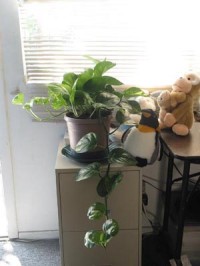 |
| image
9 |
Plants are often classified as needing
low, medium, or high light. As a guide, figure low light to be that from a
north-facing window, medium from an east- or west-facing window, and high from a
south-facing window. Another way to judge exposure is by the shadow cast by the
plant. If it is barely discernible, the light is low; when the shadow is present but
indistinct, light is medium; when the shadow is sharp, the light is
bright. Choose plant types according to the light conditions you can give
them (image 9)
It is also possible to give too much light to a plant, resulting in compacted growth and burned
foliage. If this happens, move the plant farther from the window or put a sheer curtain on the
window.
Windowsill plants tend to lean toward the source of light. To keep houseplants
shapely, give their pots a quarter turn every time you water.
Pest Control
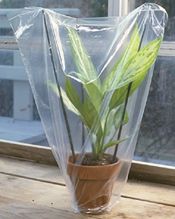 |
| image
1 |
Houseplant pests can spread and multiply
rapidly. Act quickly to minimize damage at the first sign of insects. Isolate affected plants and begin control
measures. If a pesticide is called for, be sure to use one that is labeled for indoor
use, such as an insecticidal soap spray or a houseplant spray containing
pyrethrum.
If your plant has a pest problem, you will want to contain the
pesticide, for both effectiveness and safety. Plastic around the plant will accomplish
both. Remove the plastic after several
days (image 1).
Raising Humidity
Most plants, with the exception of cacti and succulents, like high
humidity. Misting is a way to raise humidity, but you'll need to do it several times a day to be
effective (image 2).
|
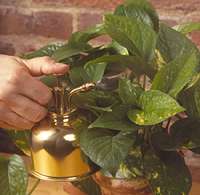
|
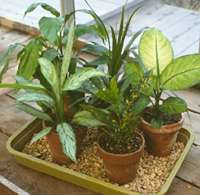
|
|
image 2 |
image 3 |
Another way to raise humidity around plants is to group them together on a tray of wet
gravel. Put enough gravel in the tray so the pots will not sit directly in
water (image 3).
Trimimg
Periodic
grooming keeps houseplants, such as these miniature African violets,
looking good (image 4). As flowers fade, clip them off to direct the
plant's energy toward growth and flower production, not toward the
production of seeds. Pinch the growing tips of foliage houseplants to
encourage dense, bushy growth. For a shapely plant, prune off any
wayward or misshapen stems.
Often,
heat or dry conditions can cause plant foliage tips to turn brown and
dry out. If this occurs, use scissors to cut off the browned tips at
an angle (image 5).
Fronds
of Boston ferns can turn brown. Use scissors to clip off brown fronds
at the base. Yellow or brown foliage on other plants also should be
removed (image 6).
Keep them clean
Large, smooth-leaved plants are frequently collectors of
dust. In normal housekeeping chores, wash or wipe away dust to keep the plant attractive and to keep it photosynthesizing at its
best (image 7).
|
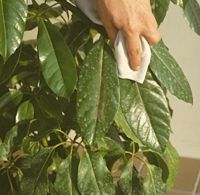
|

|
|
image 7 |
image 8 |
Hairy-leaved
plants such as African violets also collect dust. Because
moistening the leaves can cause unsightly spots, remove dust
with a small paintbrush or by blowing it away (image 8).
Bobby
Keziah
www.houseplants4less.com
